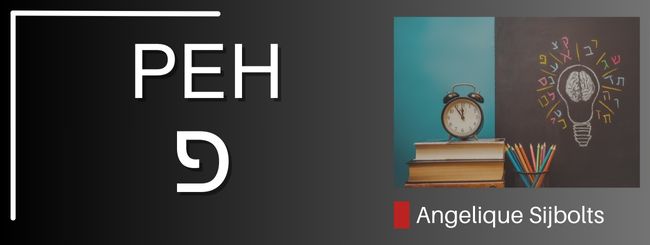
The 17th letter of the Aleph-Beis is the Peh.
It is the third letter we saw, in the first blog, in the word “aleph”.
The name Peh is related to the word Lamad – פֶּה which means mouth.
The second letter of the word is the heh – ה
The mouth makes man a human being, able to fulfill the ultimate purpose of Creation: to sing the praises of the Almighty and to study His Torah. As the Psalmist (115:17) says, The dead do not praise G-d – but living people do, by virtue of ther speech (Pesikta Rabbasi 2).
The פ has the sound “p” when it contains a dot and the sound f when it does not contain a dot. The dot is called “dagesh”. A dages can represent two things, in this case the sign indicates a hardened pronunciation of the letter (P is harsh and f is soft) This dagesh is called a dagesh lene.
It occurs only in the so-called “begadkepat” (bet, gimel, chaf, peh and taw) letters. In modern Hebrew only bet, chaf and peh appear.
In Exodus 15:26 we see:
כִּ֛י אֲנִ֥י יי רֹפְאֶֽךָ
“I am G-d, your Healer.” Is written without a dagesh.
In Exodus 21:19 we see:
וְרַפֹּ֥א יְרַפֵּֽא
“He [ a human physician] shall cause [the patient] to be healed,” is written with a dagesh.
This difference teaches that a physician’s healing might be harsh and painful and leaves physical or mental scars, the healing of G-d is always gentle and natural (Baal Haturim).
In addition, the peh also has a variant that is only used as a final letter ף , i.e. at the end of a word.
The פ stands for a closed mouth and the ף stands for an open mouth. There are times to speak and there are times to be silent.
When you are learning Torah you keep your mouth closed when you are listening to the Sages. When you have listened well enough and you are able to open your mouth, then you go to those you can teach.
In the פ we see a letter ב. This is the letter bet. We will discover this letter in the next blog.
However, for the meaning of the Peh, it is good to know that the bet has the gematria of 2. You can give people a good feeling or a bad feeling. You can praise G-d or the opposite.
We are now familiar with the: א ל פ (ף) and with the: ּ ֶ ָ ַ
and can now read the following words, among others:
Genesis 2:7
וַיִּ֩יצֶר֩ יי אֱ”לֹהִ֜ים אֶת־הָֽאָדָ֗ם עָפָר֙ מִן־הָ֣אֲדָמָ֔ה וַיִּפַּ֥ח בְּאַפָּ֖יו נִשְׁמַ֣ת חַיִּ֑ים וַֽיְהִ֥י הָֽאָדָ֖ם לְנֶ֥פֶשׁ חַיָּֽה׃
“G-d formed the Human from the soil’s humus, blowing into his nose the breath of life”.
The Hebrew word for “nose” is אַפ. When it is written “loose” it is written with a slotpeh אַף. Here the word is part of a compound word and then it is written with the פ. How words are compounded we will learn later.
Amos 20:5
הֲלֹא־חֹ֛שֶׁךְ י֥וֹם יְהוָ֖ה וְלֹא־א֑וֹר וְאָפֵ֖ל וְלֹא־נֹ֥גַֽהּ לֽוֹ׃
Surely the day of the L-RD shall be
Not light, but darkness,
Blackest night without a glimmer.
(We have not yet learned the two dots under the peh. These two dots are called tseree. They represent the long e-sound.)
Learn more about the Peh


By Angelique Sijbolts
Sources: ChabadVideo en The Wisdom in the Hebrew Alphabet by Artscroll
© Copyright, all rights reserved. If you enjoyed this article, we encourage you to distribute it further.
